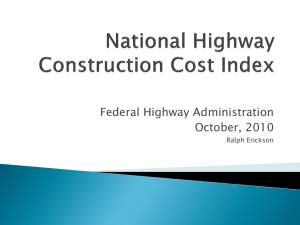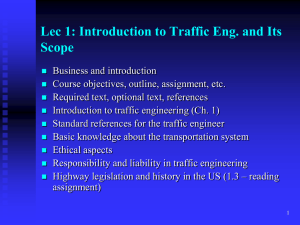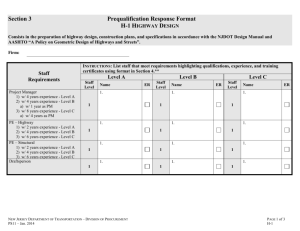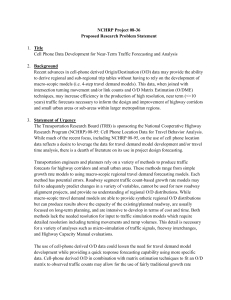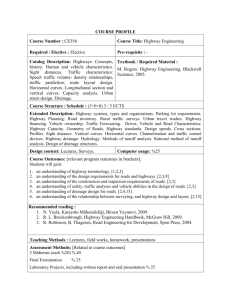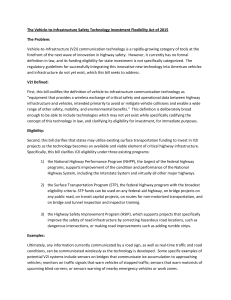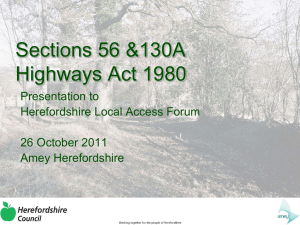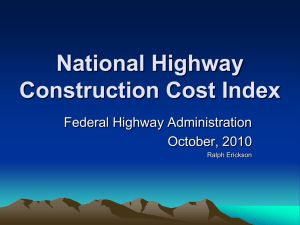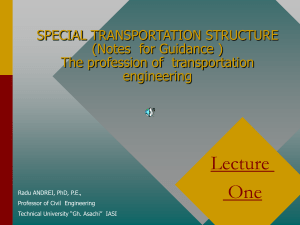Course Overview
advertisement
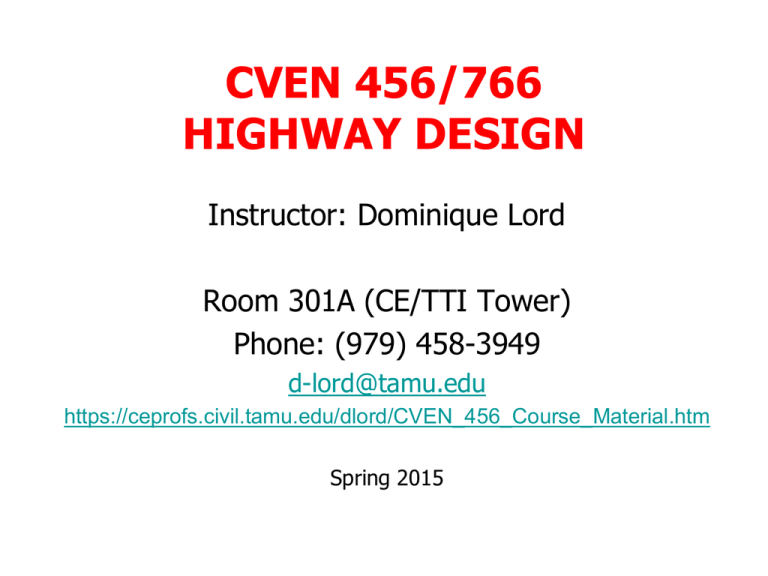
CVEN 456/766 HIGHWAY DESIGN Instructor: Dominique Lord Room 301A (CE/TTI Tower) Phone: (979) 458-3949 d-lord@tamu.edu https://ceprofs.civil.tamu.edu/dlord/CVEN_456_Course_Material.htm Spring 2015 TEXTBOOK • Required Text: Can be found at AcademicPub.com: http://academicpub.sharedbook.com/serve/ac/acapub/stud ent_product_page.html?slug=1421083553_83_635 (you’ll need to register to access this link) eBook: $49.90 (Need to install Adobe Digital Editions, 2nd Ed) B&W Hard Copy + eBook: $78.32 (Color version is available, but is not needed) I suggest that you by the hard copy, since you will need it for the labs and capstone project. TEXTBOOK • Highly Recommended: – A Policy on Geometric Design of Highway and Streets, 5th or 6th Ed., American Association of State Highway and Transportation Officials (AASHTO), 2004 or 2011 (First four chapters included in Ebook) ($225+) – Schoon, J.G. Geometric Design Projects for Highways: An Introduction, 2nd Edition, ASCE, Reston, Va., 1999. (First three chapters included in Ebook) – Roadway Design Manual, Texas Department of Transportation, Austin, Tx, Revised May 2010 http://onlinemanuals.txdot.gov/txdotmanuals/r dw/rdw.pdf TEXTBOOK • Other relevant material: – Wright, P.H., and Dixon, K. Highway Engineering. 7th Ed., John Wiley & Sons, Hoboken, N.J., 2004. – Lamm, R., Psarianos, B., and Mailaender, T., Highway Design and Traffic Safety Engineering Handbook, McGraw-Hill, New York, New York, 1999. – Staplin, L., Lococo, K., Byington, S., and Harkey, D. Highway Design Handbook for Older Drivers and Pedestrians. U.S.DOT/FHWA Publication No. FHWA-RD-01-103. Washington, D.C., 2001. TEXTBOOK • Other relevant material: – Fitzpatrick, and Wooldridge, M. NCHRP Synthesis 299, Recent Geometric Design Research for Improved Safety and Operations, Transportation Research Board, 2001. http://onlinepubs.trb.org/onlinepubs/nchrp/nch rp_syn_299.pdf – The Access Board, Accessible Rights-of-Way: A Design Guide, 2002. www.access-board.gov – FHWA, Flexibility in Highway Design, Washington, D.C., 2005. http://www.fhwa.dot.gov/environment/flex/index.htm OBJECTIVES • Provide fundamental engineering knowledge for designing rural and urban highways • Show fundamental principles and theory governing the design of highways • Apply these principles using real concrete examples • Apply the skills and knowledge learned in this course in practical applications (private & public) COURSE OUTLINE • Week 1: Course Outline/Civil 3D seminar (Mr. Hadi K. K.) • Week 2: /Highway Functional Classification • Week 3: Design Controls • Week 4: Route Selection • Week 5: Earth Work/Costs (Guest lecturer) • Week 6: Highway Design Process COURSE OUTLINE • Week 7: Sight Distance • Week 8: Horizontal Alignment (1st Presentation) • Week 9: Vertical Alignment • Week 10: Cross Section Design (Guest Lecturer) • Week 11: Intersections COURSE OUTLINE • Week 12: Highway Characteristics/Environmental Issues (Guest Lecturer) • Week 13: Time devoted to capstone project • Week 14: Review (2nd Presentation) • Term Project Due on Wednesday, May 6th • Term Paper (graduate students) Wednesday, May 6th Laboratories • • • • Thursdays 2:20 – 5:10 pm Team of 3-4 people (1 group per table) Software: Civil 3D Hand-written and computer output designs • Professional reports Term Project • Same team as for the laboratories • Software: Civil 3D • Covers all aspects of highway design and operations • Project(s) to be determined • Practicing Engineers will provide mentorship – 1 per group • Computer output designs and technical report • Two presentations (mid-term and at the end) GRADING • CVEN 456: – Labs: 30% (4-5) – Term Project: 55% – Assignments: 15% (4-5) • CVEN 766: – – – – Labs: 30% (4-5) Term Project: 55% Assignments: 15% (4-5) Term paper: 10% OTHER RELEVANT INFORMATION • Office Hours: – Wednesday 1:00 pm – 3:10 pm – Thursday: 11:00 am – 12:10 pm • I may take attendance (random) • Must have a valid reason to miss a class (See TAMU guidelines) • You are responsible for the material covered in class and in the Ebook/textbook • Any modification to the content of the course will be discussed in class
